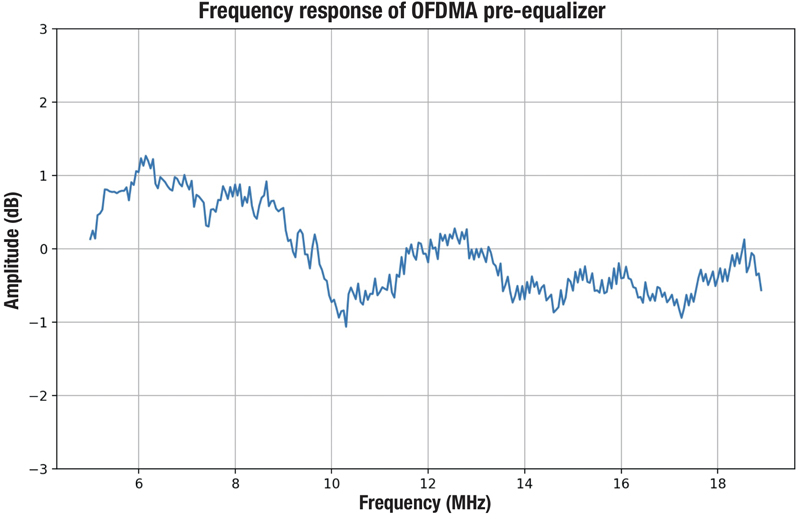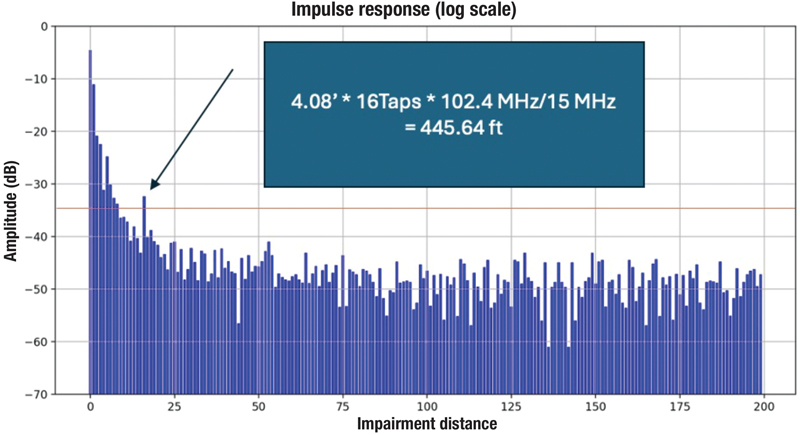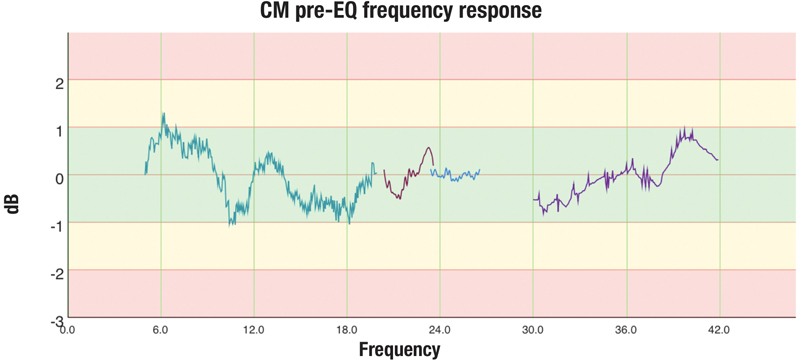DOCSIS 3.1 Supercharges RF Impairment Detection in HFC Networks with Advanced Techniques Like Never Before
By Brady Volpe
As hybrid fiber/coax (HFC) networks have expanded to deliver more robust broadband services, ensuring network reliability and performance has become a top priority for cable operators. DOCSIS® has long been the foundational technology enabling efficient and high-speed data transmission over HFC networks. With each new iteration, DOCSIS has introduced technological improvements that enhance its capabilities, and DOCSIS 3.1 is no exception. DOCSIS 3.1 has revolutionized the process of detecting and troubleshooting radio frequency (RF) impairments, which are a major source of network performance issues impacting subscribers.
Accurate RF impairment detection is vital for maintaining high-quality service, which was a theme at SCTE TechExpo24, even over speed! Prior to DOCSIS 3.1, the tools for detecting such impairments, while functional, lacked high precision required to locate impairments with pinpoint accuracy. This article explores how DOCSIS 3.1’s innovative technologies, including orthogonal frequency division multiplexing (OFDM) and orthogonal frequency division multiple access (OFDMA), combined with proactive network maintenance (PNM), provide cable operators with unprecedented visibility into their networks, resulting in more precise troubleshooting and enhanced service quality.
DOCSIS 3.1 features enabling accurate RF troubleshooting
Advanced Modulation Techniques: OFDM and OFDMA
At the heart of DOCSIS 3.1’s improved RF troubleshooting capabilities are its advanced modulation techniques, specifically OFDM for downstream communication and OFDMA for upstream communication. These technologies offer transformative improvements in impairment detection.
OFDM and OFDMA channels are divided into many narrowband subcarriers, which allows more granular control and monitoring of signals across the frequency range. This granularity enables the cable modem’s downstream equalizer and upstream pre-equalizer to provide two critical charts: the pre-equalizer response and impulse response charts (see Figure 1 and Figure 2). These charts offer a detailed view of how the network is reacting to transmitted signals and identify impairments along specific frequency ranges.
From [2] we know that the theoretical time resolution for each OFDMA channel is 4.8828 ns for each pre-equalization time domain bin. This translates to about 4.08 ft over series 6 cable (assuming velocity factor 0.85):
In Figure 1, we observe an OFDMA channel that spans 15 MHz. From the information provided in [2], we know that the distance formula of 4.08 feet must be adjusted from a channel width of 102.4 MHz to 15 MHz. This adjustment is reflected in the formula within Figure 2, where 102.4 MHz is divided by 15 MHz, resulting in an echo cavity measurement of 445.64 feet. With a narrower channel width of 15 MHz, the accuracy of impairment detection is reduced to 15 feet. However, as the OFDMA channel width increases, the accuracy improves, reaching a precision of 4.08 feet—significantly better than the 50-foot accuracy achieved with single carrier quadrature amplitude modulation (SC-QAM) channels.

Figure 1. Frequency response of the DOCSIS 3.1 cable modem OFDMA pre-equalizer.

Figure 2. Impulse response of the DOCSIS 3.1 cable modem OFDMA pre-equalizer—showing a 16 tap echo, representing a 445 foot echo cavity, causing the amplitude ripple in Figure 1.
One of the key advancements in DOCSIS 3.1 is the improved accuracy of troubleshooting enabled by its advanced modulation techniques. For instance, a single OFDM downstream channel allows for precise RF impairment detection, offering detailed insight into where impairments may occur. Likewise, a single OFDMA upstream channel provides a similar capability in the return path, with much higher precision compared to traditional SC-QAM channels.
The shift from SC-QAM to OFDMA enhances impairment detection accuracy by at least six times. While SC-QAM systems could pinpoint impairments within roughly 50 feet, OFDMA reduces this margin of error. This dramatic improvement is invaluable for cable operators, enabling faster, more precise repairs and minimizing subscriber downtime. Furthermore, the deployment of additional OFDM and OFDMA channels increases visibility into the overall health of the network, allowing operators to both proactively and reactively address potential issues before they impact users.
Figures 1 and 2 demonstrate that the amplitude ripple observed in Figure 1 corresponds to a 445-foot echo cavity in Figure 2, with a margin of error of approximately 7.5 feet. This level of accuracy was previously unattainable in DOCSIS 2.0 and 3.0 networks. Now, cable operators and technicians can more easily locate and resolve impairments, whether the coaxial cable is aerial or buried.
Lastly, the level of detail in channel response becomes particularly clear in Figure 3 when comparing the OFDMA channel response to that of SC-QAM. Figure 3 shows two OFDMA channel responses—one spanning from 5 MHz to 20 MHz and another from 30 MHz to 42 MHz—alongside two SC-QAM channels between 20 MHz and 27 MHz. The OFDMA blocks provide substantially greater detail on upstream flatness and offer enhanced visibility into noise on the channel, particularly within the upper OFDMA block.
Expanding capabilities beyond the upstream
While the earlier example focused on upstream troubleshooting, DOCSIS 3.1 extends its powerful RF impairment detection capabilities to the downstream as well. This is a game changer because DOCSIS 3.1 has standardized downstream equalization functionality across all cable modems. As a result, cable operators can now analyze the cable modem’s equalization data to determine how much each modem is equalizing the OFDM channels it is receiving.
This capability allows operators to monitor downstream channel flatness, much like traditional sweep signals used in RF networks. Additionally, it enables the detection of noise and impairments within an OFDM channel, offering a granular view of signal quality that was previously unavailable. In essence, DOCSIS 3.1 has embedded a network analyzer into every cable modem, giving operators real-time insights into the health of the downstream channels and allowing for quicker detection and resolution of impairments.
More reading: SCTE standards and PNM
To fully understand how DOCSIS 3.1’s enhanced tools work to proactively detect and resolve RF impairments, it’s essential to dive into two important industry references: SCTE 280 2022 and SCTE 294 2021r1. These documents provide the technical foundation for PNM and explain how DOCSIS 3.1 leverages its capabilities to monitor and address potential network problems before they impact users.
The SCTE 280 industry reference outlines the key metrics, such as micro-reflections and channel response, that PNM collects from both the cable modem termination system (CMTS) and the cable modems. By continuously analyzing these metrics, PNM can detect upstream and downstream impairments and assess network health.
The SCTE 294 industry reference goes even further by explaining how DOCSIS 3.1’s OFDM and OFDMA subcarriers provide deeper insights into RF impairments. These documents guide operators in utilizing subcarrier-level data to identify where impairments are occurring with greater accuracy, enabling more proactive network maintenance and faster resolution of issues.
For those looking to deepen their knowledge of how DOCSIS 3.1 enables these enhanced capabilities, reading SCTE 280 and SCTE 294 is highly recommended. These industry references will give you the technical insights needed to fully grasp the power of PNM and its role in maintaining stable, high-performance networks.
Finally, for more detailed insights on OFDM and OFDMA channel response, be sure to read Tom Williams et al.’s 2021 Fall Technical Forum paper, “OFDMA Predistortion Coefficient and OFDM Channel Estimation Decoding and Analysis,” available at https://tinyurl.com/yx8edp47. Additionally, look out for Larry Wolcott et al.’s paper, “The Proactive Network Maintenance Comeback,” which is expected to be published on NCTA 2024 Fall Technical Forum archives. Both papers dive deep into OFDM and OFDMA technologies and provide detail on how they contribute to RF impairment detection and network maintenance.

Figure 3. OFDMA and SC-QAM pre-equalizer response shown together. Notice the higher level of detail visible in the OFDMA channels (far left and far right) compared to the SC-QAM channels (center).
Conclusion
DOCSIS 3.1 represents a major leap forward in the ability to detect and troubleshoot RF impairments in HFC networks. By utilizing advanced modulation techniques like OFDM and OFDMA, DOCSIS 3.1 provides cable operators with greater visibility and precision in identifying impairments, improving accuracy from 50 feet to as little as three feet. The introduction of LDPC error correction, combined with powerful tools such as PNM and full band capture (FBC), ensures that operators can maintain high-quality service with minimal downtime.
As cable operators continue to deploy more OFDM and OFDMA channels, their ability to detect and resolve impairments will only improve, leading to even more reliable networks in the future. DOCSIS 3.1 has truly revolutionized the field of RF troubleshooting, empowering operators to deliver better service and maintain healthier networks.
References:
- Williams, Tom, et al, (2021), OFDMA Predistortion Coefficient and OFDM Channel Estimation Decoding and Analysis, SCTE Fall Technical Forum, October 11-14, 2021
- Wollcott, Larry, et al, (2024), The Proactive Network Maintenance Comeback, SCTE TechExpo24.
 Brady Volpe
Brady Volpe
Mr. Volpe, the Chief Product Officer at OpenVault, brings over 30 years of experience in the broadband cable and telecommunications industry. As the founder of The Volpe Firm, Inc and Nimble This (now OpenVault), he has been instrumental in product development and successful launches. Through his acclaimed blog, podcast, and livestream, he shares expertise in high-speed data, DOCSIS, PNM, HFC, ML, PMA, RF, AI and more. Mr Volpe has an unwavering commitment to broadband innovation.
—
Image provided By Author
